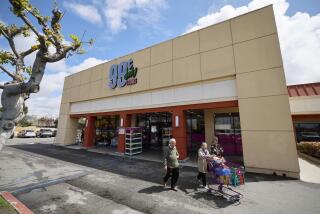Downey S & L Puts 20 Neighborhood Shopping Center Parcels on Market
- Share via
Taking advantage of a seller’s market in commercial properties, Downey Savings & Loan said Wednesday that it wants to sell 20 neighborhood shopping centers--more than a fifth of the centers it owns.
Downey, which recently moved into new headquarters in Newport Beach, is asking $182 million for the 20 centers.
Bid packages describing the properties, 13 in California and seven in Arizona, were mailed this week to more than 100 major institutions interested in commercial property, said John Dennis, a Downey spokesman.
Putting 20 shopping centers on the market is unprecedented for Downey, which has earned a reputation as one of the nation’s best-managed S & Ls, in part by building the centers and keeping them in its investment portfolio.
Last year, Downey’s real estate represented only 7.8% of its assets but generated 27% of its total revenue and 27% of its operating earnings.
Downey said it owns about 90 shopping centers, but it could not provide an exact number.
Proceeds from the sale, which the S & L hopes to conclude in a package deal in the next few months, will fuel Downey’s growth plans and help to finance more than 40 real estate projects now in the works.
“This will provide additional funds for our home loan program as California’s population continues to grow and the demand for housing and commercial development remains high over the next several years,” said Maurice L. McAlister, Downey’s president.
McAlister, who keeps his finger on the pulse of the commercial market, decided it was time to sell a large group of centers because “it was time to cash in” while investors are clamoring for such properties.
Demand is great now for a limited supply of retail centers that can show the kind of profits Downey’s centers generate, industry analysts said.
If the S & L can sell all 20 properties this year, it would realize an after-tax gain of $5 a share, said James Wilson, a research analyst with the San Francisco investment banking firm of Sutro & Co.
But Wilson and his research colleague, Dan Williams, doubt that the S & L can sell the centers in a single package or conclude a batch of separate transactions in the five months remaining this year.
Williams said that the properties are spread out geographically and that few companies would want to oversee such a wide-ranging domain. The California centers are spread from Sacramento in the north to Calexico at the Mexican border, and the Arizona centers range from near the Utah state line to the Mexican border.
While two of the centers are in upscale Rancho Cordova outside Sacramento and La Quinta near Palm Springs, a number are in smaller desert communities like Victorville and Hesperia.
“The Japanese have started buying real estate in the suburbs and outside of metropolitan areas,” Wilson said. “But I don’t think you’re going to see them go to the desert.”
Downey is not selling its choicest centers--such as ones in “hot” markets like Newport Beach, Costa Mesa and Lake Forest--but is keeping them in its in its portfolio.
Nevertheless, the cash flow at nearly all of the S & L’s shopping centers is good, the two analysts said. And that cash flow is protected by leases that contain cost-of-living clauses, which guarantee increased income over the years and make the centers more attractive to buyers.
Of the centers up for sale, 16 have vacancy rates of less than 10%, three have rates less than 15% and one--in Carmichael, Calif.--is new and has 65% of its space available for lease. The 20 properties contain 1.6 million square feet of commercial space already built and have room for an additional 554,563 square feet.
Williams and Wilson also agreed with another analyst, Gerald Haims of Seidler Amdec Securities in Los Angeles, that Downey has made a smart move in selling some of its stockpile of centers because the market for them is so good.
Barely three months ago, McAlister said the S & L planned to sell only two shopping centers this year. For more than a decade, Downey rarely sold any of its shopping centers, though the S & L averaged a $2-million profit on the few it did sell. Downey instead regularly sells its interests in residential, office and other commercial projects it helps to develop.
The S & L has preferred to keep its centers because “the income stream is worth more to us” than the profit from a sale, McAlister said at the time. “It doesn’t make sense to sell assets that are making us money. . . . And no loan will produce as much income as a neighborhood shopping center does.”
He changed his mind recently when he realized the S & Ls could capitalize on a sale and convert its healthy cash flow into healthy profits.
More to Read
Inside the business of entertainment
The Wide Shot brings you news, analysis and insights on everything from streaming wars to production — and what it all means for the future.
You may occasionally receive promotional content from the Los Angeles Times.










